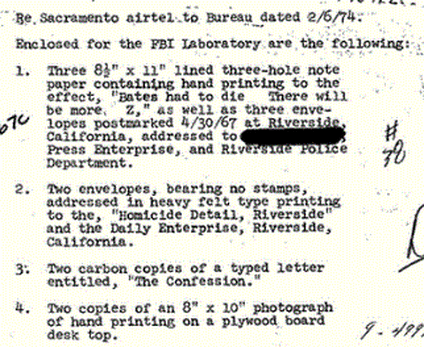The Riverside library photocopying machine was likely purchased to accommodate the college paper they stocked.
A photocopying machine, where students could secure 8 1/2 X 11 inch black and white copy of printed or typed material, was available at the library for ten cents in 1966. Hours of service are: Monday through Thursday 7:45 a.m. – 10:00 p.m.; Friday 7:45 a.m. – 4:30 p.m.; Sunday 1:00 – 5:00; 6:00 – 9:00 p.m.
This is nothing conclusive, but nevertheless is food for thought. The Bates letters were written on lined 8 1/2 X 11 inch paper, and the carbon copy Confession letter paper was torn top and bottom. This may very well have been torn to remove distinguishing features from the photocopying process, that may very well have identified a particular machine and specific location.

I could be wrong, but I thought the original Confession letters were written on teletype paper using carbon copies of low quality (multiple layers down), so as to mask any evidence from the specific typewriter used? They weren’t photocopies, but it does still ask the question where did he get the teletype paper, carbon paper, etc. I would think if the original copies still exist in Riverside’s unreleased file, there could be traceable evidence. What was the paper? If it was teletype, where did he get it from- scrap from a teaching lab at RCC, working at a Western Union?
What kind of carbon sheets were used to make the copies (I have no idea if there were different blends of chemicals used to make them, but it wouldn’t surprise me if that was the case and could be traced by brand).
I wish Riverside would release their full records, obviously they are hiding something. And so many of these things could be tested now with such a small sample size, I find the whole thing ridiculous. A case that cold should be released to the public.
-m
The problem when solved will be simple– Kettering
I don’t know of hardly any (if any) who will release documents in cold cases. While we would find it informative, it could hurt their case–even after all these years.
Consider it extraordinary that folks got their hands on some police reports!!
I don’t know of hardly any (if any) who will release documents in cold cases. While we would find it informative, it could hurt their case–even after all these years.
Consider it extraordinary that folks got their hands on some police reports!!
Actually, I think its starting to become a trend as cold case divisions start reinvestigating. Sometimes there might not be info released at first, but time changes a lot for people who maybe alibied someone like an SO, a good friend at the time, someone they feared retribution from…. and now they are bitter so the truth comes out. Or maybe a clue the police were holding back to know if the real perp comes forward or a reliable witness (something a simple as a brand of cigarettes), it might spur someone in the public’s memory. Or maybe someone who heard a jailhouse confession. There are lots of possibilities. Or I’ve been watching too many reality cold case shows on TV!
In CJB’s case, and this is JMHO, the police are covering for something and it won’t hurt their case. They have DNA off her clothes, there are clear aspects of the crime that don’t make sense as explained. Everyone makes mistakes, 50+ years cold…
FOIA and FOIL(NYS) are there to make sure our public officials do their due diligence. I think Riverside needs to release everything they have, and I am fine with it going to labs for testing. But they missed something big, or were covering for someone. Or they were incompetent.
-m
-m
The problem when solved will be simple– Kettering
Personally, I’m not 100% clear on whether this carbon copy business has been satisfactorily confirmed.
Not saying it hasn’t, I just don’t remember.
It’s mentioned in Graysmith, I think, but that’s hardly satisfactory.
If you look at the first post, it is part of the FBI FOIA. #3 lists two carbon copies of "The Confession." You can find the entire document pg 161-3 here:
https://vault.fbi.gov/The%20Zodiac%20Ki … %2006/view
It does state that they were the carbon copies received and it it unknown if the original was sent to anyone. The Riverside police also request the letters be returned since they are not copies but the letters they received so I am guessing it is factual that they were, in fact, carbon copies.
-m
The problem when solved will be simple– Kettering
Nice work Marie!

